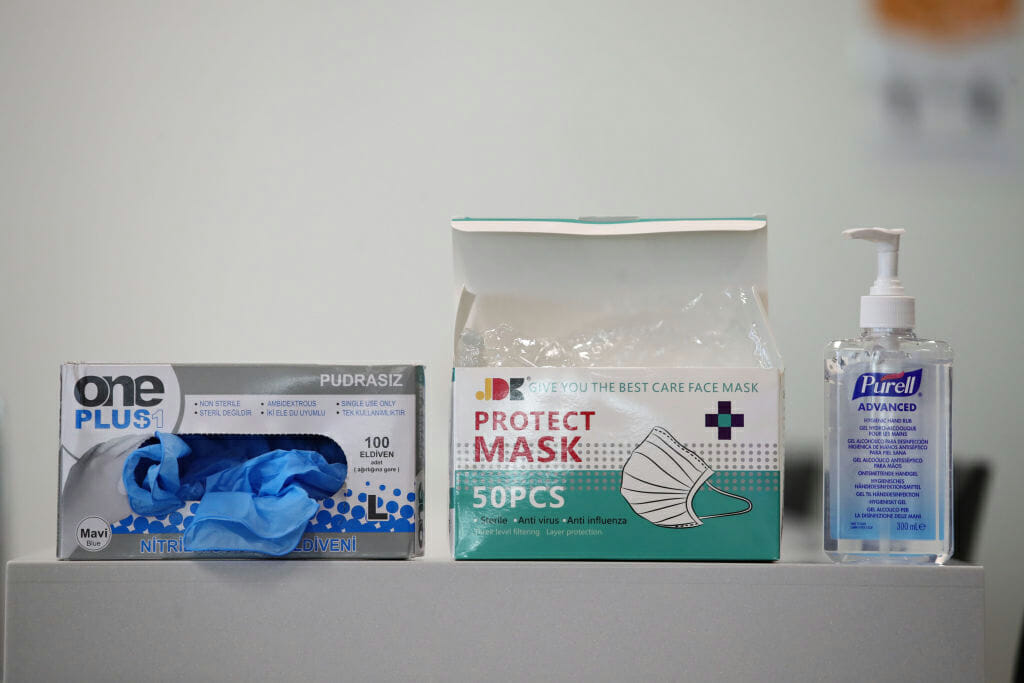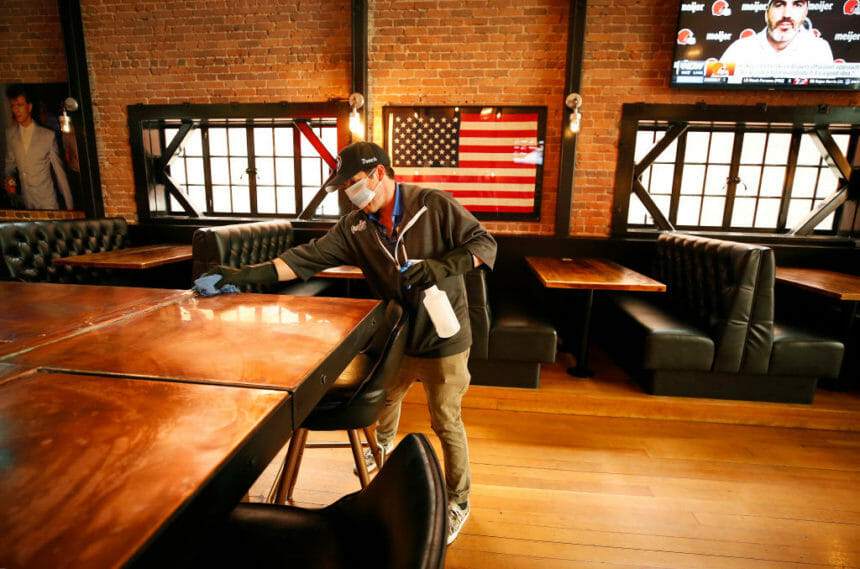We begin this week with a cautionary tale titled “What community transmission looks like.” An event held in February to celebrate the opening of a bar in rural Illinois led to 46 cases of COVID-19, including 26 patrons of the bar, three bar employees, and 17 people who weren’t there at all but got infected by someone who was.
Submitted for your consideration are the pertinent findings:
- Four people who attended the event had COVID-19-like symptoms that day. One attendee was asymptomatic but had received a confirmed diagnosis of COVID-19 the day before the party.
- Attendees reported inconsistent use of masks and failure to socially distance despite properly spaced tables and signs encouraging these precautions.
- 25 of the 26 infected attendees developed symptoms, in most cases one to seven days after the festivities.
- The majority of the infected attendees were adults ages 18 to 44 (76%), male (65.5%), and white (79%).
- 28 of the 29 guests and bar staff who tested positive for COVID-19 had not received a COVID-19 vaccination.
- Secondary cases included 12 household contacts of partygoers, including five school-aged children.
- A local school with 650 students closed for two weeks.
- Secondary cases included an employee and two residents of a long-term care center, one of whom was hospitalized briefly. The likely source of infection was a party attendee who works at the facility as a certified nursing assistant.
- None of the four infected individuals at the LTC center—the CNA, two residents, and staffer—had received a COVID-19 vaccination although all had been offered it.
- The actual number of cases associated with the bar opening celebration was probably higher than officially reported.
Centers for Disease Control and Prevention Director Rochelle Walensky mentioned this incident in a public health briefing earlier this week, and Alicia Lasek nicely captures the nursing home perspective in McKnight’s Long-Term Care News. Perhaps the only thing surprising about the CDC’s mitigation guidelines—for businesses and individuals—is how often they need to be repeated. Beyond masking and distancing, stay home if you are sick, isolate if you are diagnosed, and get vaccinated as soon as you can.
What happens in the bar doesn’t necessarily stay in the bar.
This edition of the Coronavirus Briefing is 2,476 words long and will take you 9 minutes to read.
Living in an altered landscape
The “next normal” will likely be something old and something new.
- The number of children and adolescents who have lost at least one parent to COVID-19 in the U.S., is “staggering,” according to a research team’s demographic model—an estimated 37,300 to 43,000 as of February. By comparison, the 9/11 terrorist attacks left 3,000 children without a parent. Researchers from Stony Brook University shared their analysis in JAMA Pediatrics, using such statistical tools as a “bereavement multiplier.”
- After “I’ve been vaccinated” the next common refrain may well be “I’ve been tested (again)”. The CDC and National Institutes of Health are studying two communities, one in North Carolina and another in Tennessee, to determine if frequent self-testing for SARS-CoV-2 can reduce community transmission. In this initiative, dubbed “Say Yes! COVID Test,” up to 160,000 residents will be given rapid antigen tests to use three times a week for one month.
- One good reason why prevention of disease is so important: Nearly a third of patients hospitalized with acute COVID-19 were rehospitalized within 140 days, and 10% died, Lasek reports in McKnight’s LTC News. The study, conducted in the U.K., is one of a few pointing to a “post-COVID syndrome” that needs to be better understood, anticipated, and treated. A similar study in the U.S. suggests that sending hospitalized patients home on supplemental oxygen improves outcomes.
- The pandemic has led 4 million people into early retirement, according to the nonprofit Alliance for Lifetime Income. Early departures from the workforce are hastening the impact of a milestone known as Peak 65, the year—2024—in which more Americans will turn 65 than at any point in history. Amy Novotney has details in McKnight’s Senior Living.
- For those who intend to keep working, one in four plan to look for another job once the threat of the pandemic subsides, reports Prudential’s Pulse of the American Worker Survey. And one in three say they wouldn’t want to work for an employer that requires them to be onsite full-time. Of those planning to leave, 80% are worried about career growth and almost 75% say the pandemic has given them a chance to rethink their skill sets.
- The Clorox Company fine-tuned its online education after using an artificial intelligence tool, IBM Watson Advertising Conversations, to better understand customers’ questions and concerns about cleaning and sanitizing, Sabrina Sanchez explains in Campaign.
- Some of those cleaning concerns may ease up a bit now that the CDC has said that the risk of getting COVID-19 from surfaces is less than 1 in 10,000 per touch. Disinfecting surfaces is effective for preventing transmission of virus from an infected person to others in the same household, CDC notes, but there’s little scientific support for routinely using disinfectants in community settings, indoor or outdoor.
- Norwegian Cruise Line wants to get passengers back on board by July 4 and is willing to require proof of COVID-19 vaccination to smooth the waters. The company has written to the CDC outlining its plans. The latest CDC guidance, issued last week, recommends but does not require vaccination for passengers, crew, and port personnel.
- A state mask mandate in Alabama is expiring on Friday, but visitors to hospitals and nursing homes will still need to abide by a federal mask requirement that applies to healthcare facilities. The Alabama hospital and nursing home associations are advising their member institutions not to let down their guard.
- Employers are working to get back to some semblance of normal operations by Q3, and vaccination efforts are “job one,” according to a survey by the National Alliance of Healthcare Purchaser Coalitions. Few (8%) are anticipating mandating vaccination and just 10% are thinking about it for employees at higher risk of exposure. But 80% of large employers (those with more than 10,000 employees) plan to offer vaccination on site. Novotney has details in McKnight’s Senior Living.
- It’s not too soon to think about summer camp, is it? The American Academy of Pediatrics is thinking about it too and issuing guidelines for staying safe. It can be done, as camps demonstrated last year. A multilayered approach works well: quarantining at home pre-camp, testing staff and campers before and after arriving, doing daily temperature checks and health assessments, operating in small cohorts of campers and staff, and moving more activities outdoors. Plus rigorous disinfecting and handwashing.
The Takeaway:
We are an adaptable bunch and will find a way to cope with whatever comes next. Our hearts go out to all who have suffered irretrievable loss in this pandemic.

Clinical consequences
Treating the broad spectrum of illness presented by COVID-19 is daunting enough. People already dealing with chronic illness or other health challenges have another layer of worry.
- COVID-19 vaccination may cause enlargement of lymph nodes in the armpit, neck, and upper body, signs that may mimic cancer on imaging studies, especially CT or PET scans. To explore this diagnostic dilemma and its impact on assessment, monitoring, and clinical decision making, Cancer Therapy Advisor’s Jonathan Goodman interviewed researcher Lacey McIntosh from the University of Massachusetts Medical School.
- In a study of more than 236,000 COVID-19 survivors, one in three were diagnosed with a neurologic or psychiatric disorder within six months of their COVID diagnosis. The risk was higher in those with severe COVID-19; 46% of patients admitted to an ICU later had a neuropsychiatric diagnosis. Although researchers from the University of Oxford say this is not quite the same as “long COVID,” the two phenomena appear to be clinical cousins complicating the treatment picture.
- In a survey of New York City patients with multiple sclerosis, more than 40% missed doctor’s appointments, lab work and imaging studies in the early months of the pandemic, Amit Akirov writes in Neurology Advisor. In most cases, it was the patient doing the postponing, fearful of getting infected by venturing into healthcare settings.
- Confusion and delirium are common signs of COVID-19 in older patients, especially those with dementia. Delirium is preventable and reversible but often missed by clinicians. The good news is that prevention, recognition, and intervention tools are available. Psychiatry Advisor’s Heather R. Johnson and McKnight’s Lasek offer insights from the latest research.
- Overdose deaths represent a growing epidemic within the pandemic. Tori Rodriguez shares the disquieting details in Psychiatry Advisor. One indication: an increase in overdose-related cardiac arrests in the early months of the pandemic, peaking in May 2020 at rates twice as high as rates from the two prior years.
- In a study of 15,000 patients hospitalized for COVID-19, 201 (1.3%) suffered a stroke during their hospital stay. The risk for stroke was higher in men, Black patients, and those with an underlying condition such as hypertension, diabetes, or atrial fibrillation. Jessica Nye has more on this in Neurology Advisor.
- Intravenous immunoglobulin (aka IVIG) helped speed symptom improvement and shortened hospital stays in a study of COVID-19 patients with moderate pneumonia. Sweta Gupta unpacks the findings in Infectious Disease Advisor.
The Takeaway:Progress on the therapeutic front is encouraging and somewhat overshadowed by all the vaccine news. If we can’t always prevent this disease, the next best thing is keeping people out of the hospital and off ventilators. (See some recent good news on this front from Humanigen and its monoclonal antibody lenzilumab).

Stopping the spread
Vaccinations are wonderful but can’t do it all.
- The federal government is looking for a better mask and is willing to shell out $500,000 in total prize money to folks who can face up to the task. The Mask Innovation Challenge: Building Tomorrow’s Mask is not for the merely fanciful: judges will be looking at stuff like “inhalation airflow resistance” and “filtration efficiency … against a sodium chloride aerosol challenge.” Up to 40 regional winners will have a chance to demonstrate their products in front of an expert panel. Good luck!
- You want to see some serious (or not so serious) masks? Check out the $299 model developed by singer will.i.am and Honeywell, featuring built-in headphones and LED lights. Or the winners of the Maskies, awards handed out last year at the first-ever Coney Island Mask contest.
- Face masks, hand sanitizer, disinfecting wipes—all are tax-deductible as medical expenses, according to the IRS.
- In Carver County, Minnesota, 189 confirmed or suspected cases of COVID-19 have been linked to youth sports, including ice hockey, basketball, lacrosse, and soccer. The outbreak, driven by the now-dominant B.1.1.7 variant, claimed the life of a 62-year-old youth hockey referee in February. Youth sports are associated with COVID hot spots in Michigan and elsewhere, prompting more frequent testing.
- South Dakota health officials are looking into “several” positive SARS-CoV-2 tests among vaccinated residents and staff of an assisted living center, Kimberly Bonvissuto reports in McKnight’s Senior Living. One thing the investigators want to know: are variants involved?
The Takeaway:
“Caution fatigue” is a problem; vigilance is the answer.
The rest
- Last October Jake Immink, a 31-year-old cattle rancher in Nebraska, ignored symptoms and kept working on the family farm, until his mother checked his blood oxygen level. He ended up in the hospital, where a doctor looked at a CT scan and pronounced Immink’s lungs to be “the worst I’ve seen.” The young rancher spent four months on a ventilator with COVID-19 before undergoing a double lung transplant, the first in the state for a COVID patient. Without the transplant, doctors said he would have remained on a ventilator and died within a year.
- A nationwide fundraiser in the U.K. beginning April 30 will mark what would have been the 101st birthday of Captain Sir Tom Moore, Rebecca Cooney reports in Third Sector. Captain Tom, a World War II veteran, celebrated his 100th birthday last year by taking 100 laps around his garden with his walker, raising millions for healthcare during the first pandemic lockdown. Sadly, he died of coronavirus on February 2. This year, donations will support the Captain Tom Foundation or the charity of your choice.
- Deborah Birx, a familiar face in the White House coronavirus briefings of 2020, disappeared from public view and then resurfaced in a recent documentary about the pandemic. Her daytime gig? She has joined ActivePure Technology, based in Dallas, as chief medical and science advisor. The nearly 100-year-old company makes air and surface purification products that are “proven to eliminate more than 99.9% of the virus that causes COVID-19.”
The resources
- A case study on successful COVID-19 messaging in rural communities is the focus of a webinar scheduled for April 20, hosted by the Public Health Communications Collaborative. On the PHCC website, you can also find a recording of a recent webinar with CDC Director Rochelle Walensky, discussing the agency’s work with local health departments.
- The Health Action Alliance has put together a Quick Start Guide for employers and their role in supporting the vaccination effort. The Alliance is a partnership among business, communications and public health groups “to strengthen and accelerate the business community’s response to COVID-19 and help rebuild public health.”
- The CDC has just updated its own guidance on setting up workplace vaccination programs. If an on-site program isn’t feasible, the CDC recommends that employers support vaccination at other locations in the community—giving paid time off, providing free transportation to vaccination sites, or helping staff navigate the appointment system.
- In his Weekly Dose podcast, MPR’s Steve Duffy interviews infectious disease specialist Joshua Barocas from Boston Medical Center and covers topics ranging from coronavirus variants and herd immunity to vaccine hesitancy and defining “long-COVID.”
- In his Easter message, Pope Francis urged the international community “in a spirit of global responsibility, to commit to overcoming delays in the distribution of vaccines and to facilitate their distribution, especially in the poorest countries.” Amen.
… and some songs
A Face in the Crowd, Tom Petty
Take Me Away From the Crowd, Johnny Nash
The Way It Is, Bruce Hornsby & The Range
People Get Ready, The Impressions
Thank you for visiting! Although we are physically distanced, we’d like to think we’re socially and not just virtually near. See you next Wednesday with a Haymarket Vaccine Project Newsletter. Take care, stay well.







